|
|
|
Sort Order |
|
|
|
Items / Page
|
|
|
|
|
|
|
| Srl | Item |
| 1 |
ID:
184042
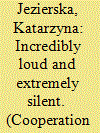

|
|
|
|
|
| Summary/Abstract |
In 2014, Sweden’s Feminist Foreign Policy (FFP) was announced with a fanfare. This article critically interrogates how Sweden implements the FFP through digital diplomacy by investigating the extent of Sweden’s gender equality activities on Twitter since the introduction of the FFP and by tracing gendered online abuse in digital diplomacy. I focus on Swedish embassy tweets towards two countries where feminism is highly contested – Poland and Hungary. The theoretical inspiration comes from discursive approaches to the spoken and unspoken, enriched by feminist observations about the non-binary character of voice/silence. The method applied is gender-driven quantitative and qualitative content analysis. The findings demonstrate that the FFP has not set any significant mark on digital diplomacy in the analyzed cases. The launching of the FFP went completely unnoticed and posts related to gender equality have actually decreased since 2014. There are no traces of ambassadors being subjected to gendered online abuse, but heavily xenophobic and paternalistic language is directed at Sweden as a representative of liberal policies. The article contributes to the literature on digital diplomacy by highlighting the (lack of) links between foreign policy and digital diplomacy and it addresses a gap by focusing on gender in digital diplomacy.
|
|
|
|
|
|
|
|
|
|
|
|
|
|
|
|
| 2 |
ID:
184039


|
|
|
|
|
| Summary/Abstract |
Why did transatlantic policymakers target Russia with economic sanctions in response to its actions during the Ukraine conflict? Commentators perceived these sanctions as highly unlikely because they would have high costs for several European countries, and were surprised when they were finally adopted. Constructivist scholars employed explanations based on common norms and trust to explain the European Union’s agreement on economic sanctions in this case. I argue that the mechanism of international emotional resonance played a decisive role in altering the course of the United States and core European Union powers’ cooperation. A framework that combines resonance with emotional influence mechanisms of persuasion and contagion explains the precise timing of the policy shift, why European policymakers accepted sanctions at a substantial cost to their economy and how norms affected policy when they were empowered by intense emotions.
|
|
|
|
|
|
|
|
|
|
|
|
|
|
|
|
| 3 |
ID:
184040
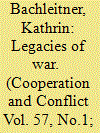

|
|
|
|
|
| Summary/Abstract |
This article is interested in the formation of war legacies and how they interact with social identities. It suggests a bottom-up approach towards examining the societal processes in which individuals create a legacy of war. It posits that through their narratives of conflict, by remembering what happened to them as a group, they mould the meaning and boundaries of how the group will be membered post-conflict. The validity of the theorised link between war memory and group membership is then tested in the case of Syria. In 200 interviews, Syrians provided their narratives of the conflict and their vision of a future Syrian state and society. The findings show that most respondents’ narratives follow a civic rationale, forming a society around civil rights and political ideas rather than around ethnic/sectarian divides. With this, the article contributes a new route for international relations scholars to understand the formation of war legacies through individuals’ narratives of conflict and explains their effects on ties of group belonging while also offering a glimpse into the Syrian ‘we’ amid the ongoing war in Syria.
|
|
|
|
|
|
|
|
|
|
|
|
|
|
|
|
| 4 |
ID:
184043
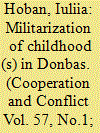

|
|
|
|
|
| Summary/Abstract |
This essay critically examines how the militarization of childhood(s) takes place in the Luhansk and Donetsk People’s Republics. The intensification of hostilities in Eastern Ukraine in mid-2014 has had a profound impact on local populations, particularly children. While no systematic recruitment and participation of children in conflict has been reported, childhood has become what Agathangelou and Killian would characterize as a ‘site for displacement and maneuvering for militarization.’ Drawing on feminist methodologies, I examine processes of the militarization of children’s everyday lives. This article investigates a range of ways in which authorities of proto-states in the Donbas region address children as participants and potential collaborators in the processes of militarization. In my analysis, I examine how war and preparation for it are simultaneously co-constituted by the geopolitical—legitimation of new proto-states—and everyday practices, such as engaging with school curricula, visiting museums, and (re)inventing historical narratives. Understanding of mechanisms that militarize childhood and how children become subjects and objects of militarization allows for a critical analysis that reveals spaces of everyday violence. This article, therefore, enhances our understanding about the intersections of childhood, militarism, and security.
|
|
|
|
|
|
|
|
|
|
|
|
|
|
|
|
| 5 |
ID:
184041
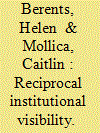

|
|
|
|
|
| Summary/Abstract |
Within the architecture of the United Nations (UN), formal recognition of the contributions of historically marginalised individuals and communities to peacebuilding denotes a positive shift in rhetoric and practice. Alongside broader institutional moves towards ‘sustaining peace’; the emergence of a ‘Youth, Peace and Security’ agenda since 2015 formalises attention to youth as positive contributors to peacebuilding and in responding to violence. This article situates the Youth, Peace and Security agenda within broader institutional and academic attention on ‘inclusive peace’. It considers the ongoing challenges in legitimising youth inclusion; and positions this emergent agenda in relation to the gains made by the Women, Peace and Security agenda, and the establishment of the UN’s sustaining peace agenda. These explorations demonstrate the value of considering the evolution of inclusive peace agendas together, while remaining mindful of their distinctive characteristics, to better understand the potential of inclusive approaches to peace. It argues that the Youth, Peace and Security agenda should be understood as a key element of shifts in UN peacebuilding practice towards inclusivity that enable visibility and legitimacy to a broader range of peace actors. We suggest that greater recognition of the contributions of youth to the broader ‘inclusive and sustaining peace’ mandates is needed.
|
|
|
|
|
|
|
|
|
|
|
|
|
|
|
|
| 6 |
ID:
184038
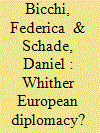

|
|
|
|
|
| Summary/Abstract |
The article analyses the evolution of European diplomacy over two decades, to assess the impact of the European External Action Service (EEAS) creation alongside consecutive waves of enlargement. Data is drawn from two original datasets about European Union (EU) member states’ diplomatic representations within the EU and across the globe. It shows that member states have maintained and strengthened their substantial diplomatic footprint across the EU’s territory, expanding it to include new members and making Brussels a diplomatic hub also for non-member countries. In parallel, and despite the establishment of the EEAS, member states have maintained and even increased their networks of diplomatic representations across the globe, alongside more numerous and more politically active EU Delegations (EUDs). At the same time, member states have been reducing their diplomats’ numbers, as the cases of Austria, France, Germany and Italy show. This delicate balancing act has been made possible not only by contemporary technological developments, but also by European cooperation, as in the case of EUDs hosting member states’ representations in non-member countries, a development referred to as co-location. Therefore, whereas the continued presence of national embassies on the ground could be interpreted as detracting from the EEAS, the existence of EUDs contributes also to other, more indirect but certainly novel, forms of diplomatic cooperation under a single European roof.
|
|
|
|
|
|
|
|
|
|
|
|
|
|
|
|
|
|
|
|
|